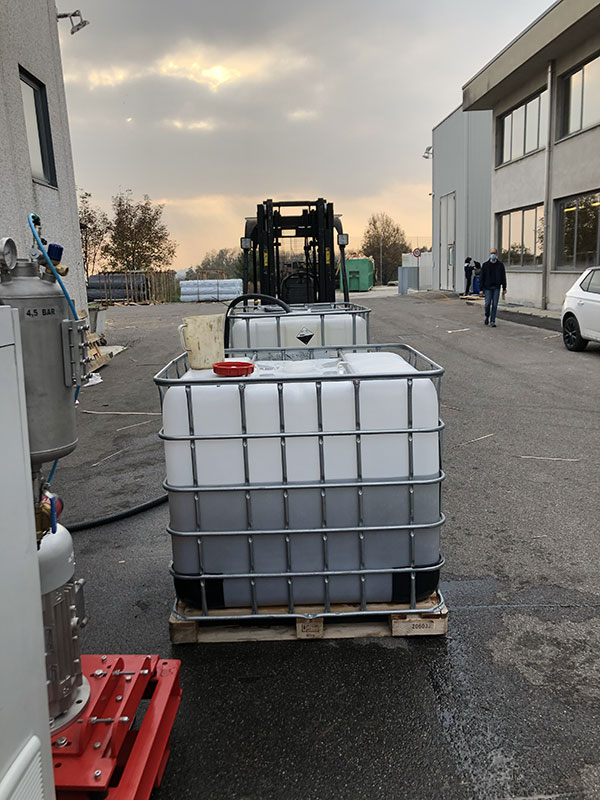In the EMPOWERING DEVICE the recipes are preset based on the identification of the incoming wastewater and, therefore, are initially divided into the macro families of Bases and Acids and then go down in depth based on the specifications of the analyzes of the AS-IS.
Based on the input parameters, based on the pre-set recipes, the system will suggest the number of steps as well as the filters and chemicals to be used and when to use them. With the aim of obtaining clean water from industrial waste that can be reused or discharged into a ditch according to the parameters of the law.
All the piping as well as the parts of the machinery in contact with the wastewater are made of 316L steel to guarantee their durability.
In wastewater treatment centers there are extremely heterogeneous types of matrices but, having to hypothesize a plant, the choice falls on a plant versatile enough to be suitable for most wastewaters: with 3 cavitators in series we can treat up to 10 cubic meters of wastewater continuously per hour with a medium-high degree of pollution (COD over 30,000). If the wastewater is less polluted we will be able to bypass some passages reducing time and consumption and, in the same way, if the wastewater is even more polluted, we will be able to use additional passages in the cavitators, however going to decrease the overall yield.
It is assumed to have the storage tanks at about 10 meters from the first cavitator and the destination tanks of the treated liquid at about 15 meters from the last cavitator; with this extension the entire wastewater treatment process will last approximately 3 minutes and 18 seconds.
The operator will then proceed to enter the characteristics of the wastewater into the system.
Upon start-up, a pump will take from the storage tank set in the system the correct quantity of wastewater to be circulated to start the treatment, sending it to the first EMPOWERING DEVICE (cavitator 1) where it will undergo 54 seconds of cavitation at 3,000 rpm (medium cycle – 6 complete loops) with simultaneous dosing of about 0.45 grams of ozone (equivalent to 6 grams per cubic metre): in this way the wastewater will undergo a first cycle of flocculation. A booster pump will make it pass, without loss of pressure and flow rate, a first sand filter where the suspended solids and floccules will instead be retained almost completely. The sand filter is self-cleaning and in non-muddy wastewater it removes an average of 0.0004 tons of material per treated cubic meter (supposed landfill disposal cost of €0.07 per cubic meter of treated wastewater).
Once the filter has passed, the wastewater will be sent to the second EMPOWERING DEVICE (cavitator 2) to be subjected to a second cavitation cycle again lasting 54 seconds at 3,000 rpm (medium cycle - 6 complete loops) where, taking advantage of the strongly acidic environment 15 grams of iron sulphate per cubic meter will be added - approximately 0.015 euros - and more ozone, approximately 0.45 grams of ozone (equivalent to 6 grams per cubic meter) or a greater quantity from an external source based on the wastewater subjected to treatment, in order to obtain a Fenton reaction of hyperoxidation by which most of the polluting agents present will be eliminated.
A second booster pump will make it pass, without loss of pressure and flow rate, a second sand filter where the suspended solids and residual floccules will instead be totally retained. The sand filter is self-cleaning and in non-muddy wastewater it removes an average of 0.0001 tons of material per treated cubic meter (supposed landfill disposal cost of €0.02 per cubic meter of treated wastewater). Once the second filter has passed, it will be sent to the third EMPOWERING DEVICE (cavitator 3) to be subjected to a third cavitation cycle again lasting 54 seconds at 3,000 rpm (medium cycle - 6 complete loops) where soda will be introduced to make the PH and other ozone, about 0.45 grams of ozone (equivalent to 6 grams per cubic meter); to bring the PH value from 1 to 7, approximately 2.8 kg of soda are needed – or 1.68 euros per treated cubic metre.
With the exception of more important quantities of ozone to be taken from devices external to the system and therefore not counted, the chemicals to be used and the sludge to be disposed of per cubic meter add up to around 1.78 euros per ton:
|
|
seconds |
kW |
notes |
|
withdrawal from tank with pump |
9 |
0,600 |
|
|
first ED |
54 |
2,640 |
no chemicals used |
|
internal relaunch ED |
4,5 |
0,000 |
counted in the ED |
|
filtration |
0 |
0,000 |
sand one |
|
second ED |
54 |
2,640 |
iron sulphate |
|
internal relaunch ED |
4,5 |
0,000 |
counted in the ED |
|
filtration |
0 |
0,000 |
sand one |
|
third ED |
54 |
2,640 |
soda to raise PH |
|
internal relaunch ED |
4,5 |
0,000 |
counted in the ED |
|
filtration |
0 |
0,000 |
graphene one |
|
relaunch |
4,5 |
0,300 |
|
|
membrane |
0 |
0,000 |
salt removal |
|
relaunch |
9 |
0,600 |
|
|
destination tank |
0 |
0,000 |
|
|
|
198 |
9,420 |
kW per m3 treated |
|
|
|
0,21 € |
kW cost |
|
|
0:03:18 |
1,98 € |
cost per treated m3 |
Therefore, the treatment cost per cubic meter of a medium-high level of pollution sample fluid with an EMPOWERING DEVICE will be approximately € 3.76 compared to more than € 15.00 for a traditional treatment system. Equally reduced is the purchase cost of the proposed system compared to a traditional system.
















